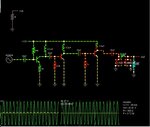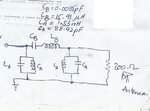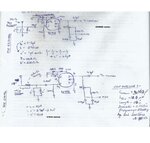- Joined
- Jul 4, 2009
- Messages
- 16,236
- Helped
- 5,140
- Reputation
- 10,309
- Reaction score
- 5,122
- Trophy points
- 1,393
- Location
- Aberdyfi, West Wales, UK
- Activity points
- 137,406
Sir Dave, be aware that this is an OOK data transmitter, modulated with a ~350Hz square wave from a 555 timer, it doesn't need linearity.
RMMK, while I appreciate your desire to learn about RF transmitters, receivers and antennas, I think you are making life difficult for yourself by choosing 27MHz where antennas are still impractical to make unless you have lots of free space around you. It is true that as the frequency is increased, the construction techniques become more critical but up to about 1GHz is still fairly easy as long as you observe good practice. I suggest you move up to about 433.92MHz which is a license free frequency in most countries and half-wave antennas are only about 35cm across.
In one of my 433MHz units, I power the transmitter, a microcontroller and a temperature sensor from a 100x35mm solar panel, use a helical antenna about 30mm long and even with a power of only about 5mW I get reliable range of over 100m.
(Sir) Brian :lol:
RMMK, while I appreciate your desire to learn about RF transmitters, receivers and antennas, I think you are making life difficult for yourself by choosing 27MHz where antennas are still impractical to make unless you have lots of free space around you. It is true that as the frequency is increased, the construction techniques become more critical but up to about 1GHz is still fairly easy as long as you observe good practice. I suggest you move up to about 433.92MHz which is a license free frequency in most countries and half-wave antennas are only about 35cm across.
In one of my 433MHz units, I power the transmitter, a microcontroller and a temperature sensor from a 100x35mm solar panel, use a helical antenna about 30mm long and even with a power of only about 5mW I get reliable range of over 100m.
(Sir) Brian :lol:








